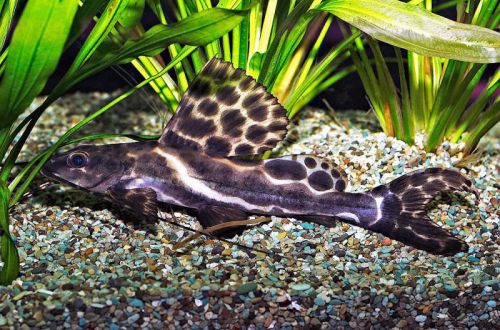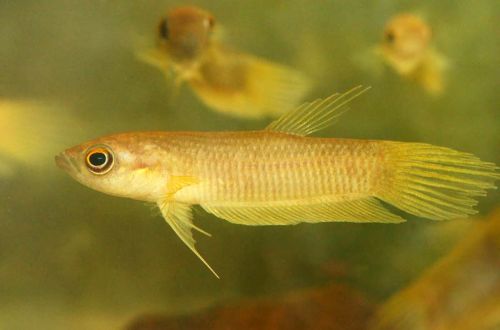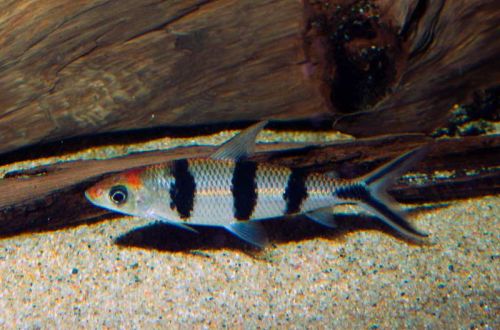
catfish sail
Sail catfish, Marble catfish or Liarinus Pictus, scientific name Leiarius pictus, belongs to the Pimelodidae family. A beautiful and unpretentious catfish, however, due to its size, it does not suit most aquarists and can hardly be considered a home aquarium fish. Unscrupulous sellers often do not inform the buyer about the real size of an adult, which later becomes an unpleasant surprise, not everyone has the means to keep such giants.

Contents
Habitat
It originates mainly from the Orinoco River basin in South America from the territory of modern Colombia and Venezuela. It lives in the main channel of the river and its large tributaries, prefers regions with a slow flow and a large number of shelters – backwaters in river bends, temporary reservoirs that appeared as a result of forest flooding during the rainy season. During the daytime, it mainly hides among the flooded trees and roots, and at night it comes out in search of food.
Brief information:
- The volume of the aquarium – from 1000 liters.
- Temperature – 22-26°C
- Value pH — 6.2–7.6
- Water hardness – soft to medium hard (5-18 dGH)
- Substrate type – smooth stones
- Lighting – subdued
- Brackish water – no
- Water movement is weak
- The size of the fish is up to 60 cm.
- Food – meat
- Temperament – conditionally peaceful when kept with large species
- Content single
- Life expectancy over 20 years
Description
Adults reach up to 60 cm in length. The coloration is dark with irregular white stripes, the pattern on the fins resembles a honeycomb – angular dark spots with a white border. The most colorful are young catfish, with age the color becomes less bright. A distinctive feature of this species is an impressive dorsal fin, its size is reflected in the name – Catfish-sail. Sexual dimorphism is weakly expressed, it is very difficult for a non-professional to distinguish a male from a female.
Food
In nature, it is a predator, but in a home aquarium it is not necessary to feed live food, catfish can take pieces of fish (white fish fillets), shrimps, mussels, large earthworms. The diet should be varied, otherwise the catfish will get used to a certain diet and will refuse other foods.
Feed once a day, you can not overfeed, in this case, digestive problems, obesity are possible, which in the long term will adversely affect health. Also, do not feed meat of animal origin (chicken, beef), which are difficult to digest.
Maintenance and care, arrangement of the aquarium
The minimum volume of the tank for one Marble catfish starts from 1000 liters. The design is quite simple: subdued lighting, several shelters and a substrate of large smooth stones, or you can do without soil at all. It should be noted that fine gravel and sand are not suitable as a substrate. The first can get stuck in the gills, and the latter is too light, such a large fish will constantly raise a cloud of turbidity when moving.
A large aquarium will require appropriate equipment that can effectively deal with a large amount of organic waste, as a rule, these are external filtration systems, their selection and installation should be entrusted to professionals. Other equipment (heating, aeration) should also be located outside the aquarium so that the catfish does not accidentally damage them.
Behavior and Compatibility
Despite its predatory disposition, it is considered a fairly peaceful fish that can be kept together with other non-aggressive species of a similar or slightly smaller size, such as Pacu. However, relationships within the species are of a completely different nature, being a territorial fish, Catfish-sail will jealously guard its place from other relatives, therefore only one catfish should be kept in a small aquarium (and in this case it is 1000 liters).
Breeding / breeding
It is almost impossible to organize the breeding of Marble catfish in a home aquarium. For sale, they are bred in commercial fish farms and are less commonly caught in the wild.
Fish diseases
The main cause of most diseases is unsuitable living conditions and poor-quality food. If the first symptoms are detected, you should check the water parameters and the presence of high concentrations of hazardous substances (ammonia, nitrites, nitrates, etc.), if necessary, bring the indicators back to normal and only then proceed with treatment. Read more about symptoms and treatments in the Aquarium Fish Diseases section.





